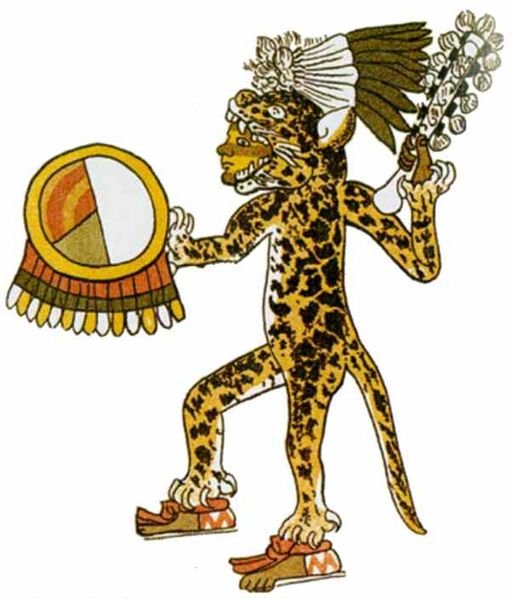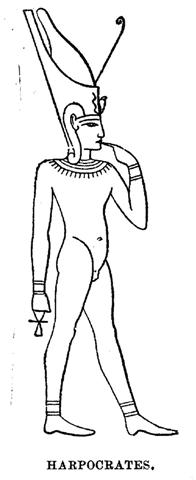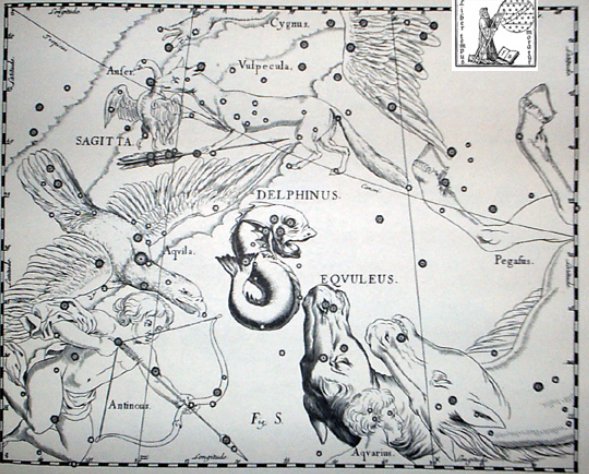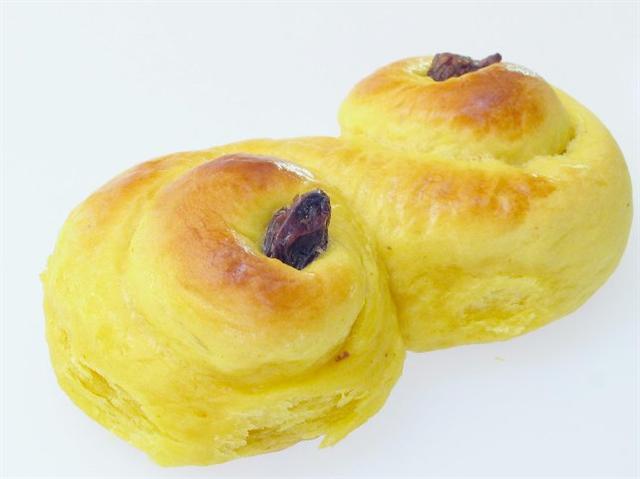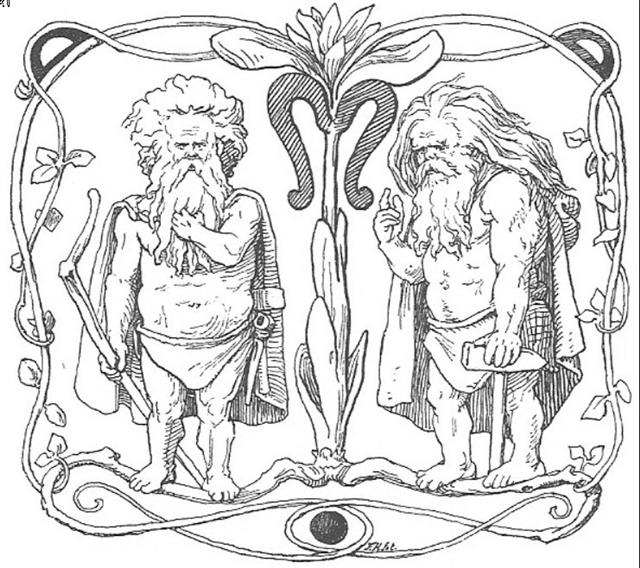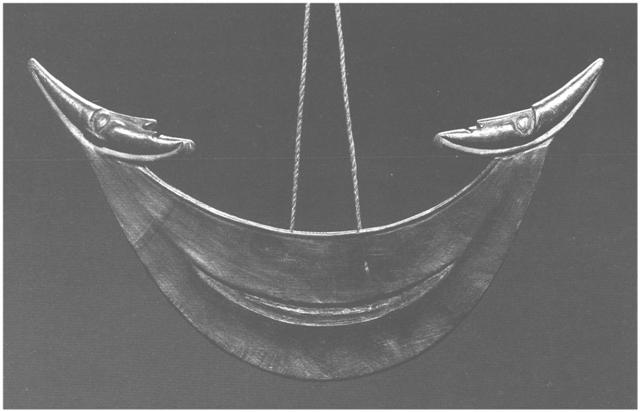They were 'strainers' - they were pushing their way into territories which belonged to others: ... In the Olympian creation myth, as Hesiod tells it in the Theogony, Uranus came every night to cover the earth and mate with Gaia, but he hated the children she bore him. Hesiod named their first six sons and six daughters the Titans, the three one-hundred-armed giants the Hekatonkheires, and the one-eyed giants the Cyclopes. Uranus imprisoned Gaia's youngest children in Tartarus, deep within Earth, where they caused pain to Gaia. She shaped a great flint-bladed sickle and asked her sons to castrate Uranus. Only Cronus, youngest and most ambitious of the Titans, was willing: he ambushed his father and castrated him, casting the severed testicles into the sea. For this fearful deed, Uranus called his sons Titanes Theoi, or 'Straining Gods' ... ... 'Oh, you, why [mo-te-aha] have you violated [toke] the borders of my [tooku] land?' The Hanau Eepe answered, 'There is not enough land [he kainga kore] to live on!' Thereupon the king called out [he rangi] to the Hanau Eepe, 'Here I stand, and I tell all of you: I am taking [he too au] you prisoners [he puru] and I am locking you up in the house of prisoners (hare kopu) for fifty [50, erima te kauatu] years!' Then the king called out [he rangi] to his men, 'Seize [ka too] all of them, and lock up all of the Hanau Eepe! Lock them up [ka puru] for good!' ... [E:55 → *55 → day 365 + 135 = 500 → 10 * 50] Our first idea from this could be to point at the effects of the precession of the equinoxes (and the solstices). Once upon a time Gemini had been at the beginning, but at the time of rongorongo it was Lono (Rongo) who marked the beginning. "292 [→ 4 * 73]. Lono; a bright star named for the Hawaiian god Lono (Maori Rongo). The statement, 'When this star is below the Moon it is the night of Lono,' indicates that Lono may be the name of any bright star below the Moon on the night of Lono, when the Moon is in the waning crescent phase, since no single star could regularly enjoy that disctinction." (Makemson) This Hawaiian view of things agrees with how Lockyer has described the ancient Egyptian terminology: ... In ancient Egypt the sun was illustrated (and thought of) as several different 'persons', defined by its phase. As Lockeyer summarized it: Hor, or Horus, or Harpocrates, and Chepera (morning sun) Rā (noon) Tum or Atmu (evening sun) Osiris (sun when set).
The cross formed by the Flail (at the right side of Osiris above) and the Crook (at his left side) are probably illustrating the pair of growth halfyears - acceleration in spring (early) respectively slowing down in autumn (late). .. At the beginning of 44 B.C. - when Ceasar was still alive - the Senate decided to raise statues of him in all the temples and to sacrifice to him on his birthday in the month Quintilis, which in honour of him was renamed July. He was raised to the status of a god (among the other gods of the state) under the name Jupiter Julius. Marcus Antonius, who this year was consul together with Ceasar, became high priest and responsible for the ceremonies. In the middle of February, at the time of the old feast of Lupercalia, he ran around ... and whipped the Roman ladies with thongs made from goat-skin, in order to promote ... their fertility ...
Lockyer also reached the conclusion that it was the relation between a celestial object and the horizon which defined it and gave name to it: '... Then, there is also the matter of the horizon as 'measurement staff' and its functional names for celestial objects. The fundamental truth that Lockyer here has found is that in the ancient world the identity of a celestial object (or of anything) is of no importance, what matters is instead relations ...'. In this frame of reference Horus = 'sun, planet, or constellation rising', Isis = 'anything luminous to the eastward heralding sunrise', and Osiris = 'any celestial body becoming invisible' ...
With this in mind we can once again look at the structure of the A text.
In addition to our first observation regarding the beginning (Ab1-1), evidently indicating day 60 - as in for instance MARCH 1 (31 + 28 + 1) = 365 + 60 = 425 = 345 + 80 = *3 45 → Hermes Trismeghistos) - the number of glyphs on each side of the A tablet underlines the measure 90. Side a carries 670 glyphs and side b carries 664 glyphs. 90 could here possibly refer to how much the precession had moved the Sun since the beginning of the present time, viz. with a quarter.... Listen,' he said as he pointed to his brothers in turn. 'You are Maui mua, you are Maui roto, you are Maui taha, and you are Maui pae. And as for me, I am Maui potiki, Maui-the-last-born ... By quickly consulting my own documentation of the G text we can find how in the timeframe (epoch) of rongorongo the Full Moon had been positioned at the Winnowing Basket (Nash, Point = γ Sagittarii, *273) at the time when the Sun had reached *90. 273 = 90 + 366 / 2 = 3 * 91 = 39 weeks.
... As has already been mentioned, the Delphians worshipped Dionysus once a year as the new-born child, Liknites, 'the Child in the Harvest Basket', which was a shovel-shaped basket of rush and osier used as a harvest basket, a cradle, a manger, and a winnowing-fan for tossing the grain up into the air against the wind, to separate it from the chaff. The worship of the Divine Child was established in Minoan Crete, its most famous early home in Europe. In 1903, on the site of the temple of Dictaean Zeues - the Zeus who was yearly born in Rhea's cave at Dicte near Cnossos, where Pythagoras spent 'thrice nine hallowed days' [27] of his initiation - was found a Greek hymn which seems to preserve the original Minoan formula in which the gypsum-powdered, sword-dancing Curetes, or tutors, saluted the Child at his birthday feast. In it he is hailed as 'the Cronian one' who comes yearly to Dicte mounted on a sow (→ Mercury) and escorted by a spirit-throng, and begged for peace and plenty as a reward for their joyful leaps ...
Here we can perceive how viri lying on its back is evolving into the beginning of a man.
... According to an etiological Hawaiian myth, the breadfruit originated from the sacrifice of the war god Ku. After deciding to live secretly among mortals as a farmer, Ku married and had children. He and his family lived happily until a famine seized their island. When he could no longer bear to watch his children suffer, Ku told his wife that he could deliver them from starvation, but to do so he would have to leave them. Reluctantly, she agreed, and at her word, Ku descended into the ground right where he had stood until only the top of his head was visible. His family waited around the spot he had last been, day and night watering it with their tears until suddenly a small green shoot appeared where Ku had stood. Quickly, the shoot grew into a tall and leafy tree that was laden with heavy breadfruits that Ku's family and neighbours gratefully ate, joyfully saved from starvation ...
... Between the back side of the head and the face - between Mother Earth and Father Sky - was the place for the ears (at the horizon with Mercury).
This could explain the curious eye formed like the figure of 8 in the illustration of Cetus above. Or the peculiar 'hair-lock' which was flowing on the right side of the head of Horus (the Sun child at the horizon in the east):
Possibly the Sign for 'midnight' north of the equator - as illustrated in the headgear of Osiris above - was used upside down to illustrate the top of the central 'noon tree'. The 'cup' had turned into a 'cap'. There was a fully grown 'hair-lock' also on the other side of the central Tree:
Below the roots of this midsummer World Tree we can see the black night of Mercury. ... The first emperor of China (Shih Huang Ti) had an enormous subterranean palace built for him as a proper place for his burial. It has been described in detail, and the ceiling (cfr French ciel, sky) was like the night sky with all its stars, whereas the floor was submerged under liquid mercury (reflecting the stars above). The beginning was at the bottom and the top was the end. And recent archeological excavations at Teotihuacan, under the pyramid of Quetzal Coatl (the Serpent with feathers from the Quetzal bird), have revealed a similar subterranean lake filled with mercury ... And we can find this Cup / Cap (northern hemisphere / southern hemisphere) also by the Mayas - although here below at the time when the Sun was moving across the equator and he turned around - apparently by 45º:
I guess the rongorongo viri type of glyph likewise was used to illustrate the point of birth (of a new 'year' beginning in high spirits) and where the old one was ending (in mourning). Although south of the equator strings maybe had to be turned into broad bands.
Clearly at least some of the rongorongo glyph types have figures which have been turned around by 90º to the right - as if illustrating how the stars had moved ahead in the sun year with about 90 precessional days.
|
||||||||||||||||||||||||||||||||||||||||||||||||||||||||||||||||||||||||||||||||||||||||||||||||||||||||||||||||||||||||||||||||||||||||||||||||||||||||||||||||||||||||||||||||||||||||||||
.jpg)
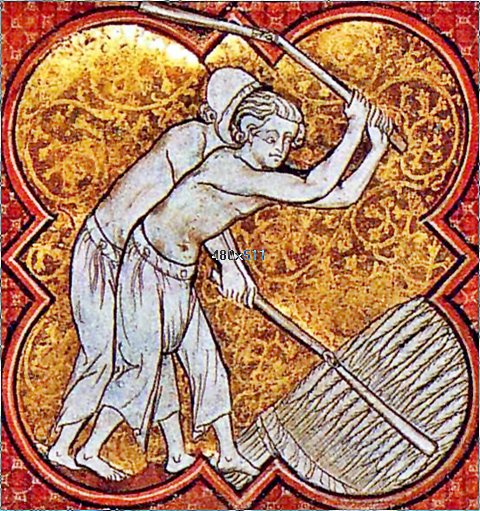
.jpg)
.jpg)

